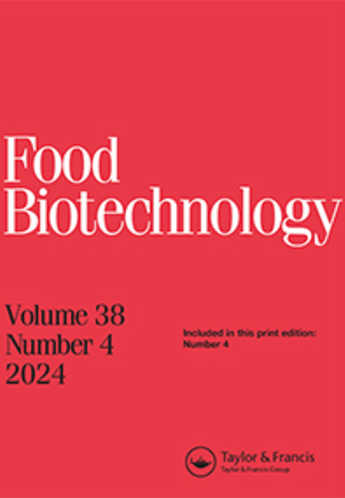Tarhana Microbiota–Metabolome Relationships: An Integrative Analysis of Multi-Omics Data
IF 1.6
4区 农林科学
Q4 BIOTECHNOLOGY & APPLIED MICROBIOLOGY
引用次数: 0
Abstract
ABSTRACT Tarhana is a fermented cereal product in which other ingredients vary depending on the traditional regional formulation. We aimed to evaluate associated relationships between metabolites and microbiota of five different Tarhana recipes belonging to Isparta, Maraş, Bursa, Kastamonu, and Uşak regions by collecting 19 samples during their fermentation process. The microbiota was investigated using metagenomics by high-throughput sequencing at species level showing Pediococcus acidilactici in Bursa, Lactiplantibacillus plantarum in Kastamonu, and Levilactobacillus namurensis and Levilactobacillus zymae in Uşak Tarhana were dominant. Also, Kluyveromyces in Isparta and Maraş, Saccharomyces in Bursa, and Issatchenkia in Kastamonu Tarhana types had the highest relative abundances. Uşak type contained the highest amounts of lactic, succinic, and acetic acids, respectively, which were also the major organic acids of all samples. Integrative analysis of multiple omics datasets revealed that Tarhana samples differing in biodiversity could be significantly clustered according to Tarhana type and production difference.Tarhana微生物群-代谢组关系:多组学数据的综合分析
塔哈那是一种发酵谷物产品,其中的其他成分因传统的地区配方而异。我们收集了来自Isparta、maraku、Bursa、Kastamonu和u ak地区的5种不同的Tarhana配方发酵过程中的19个样品,旨在评估其代谢物与微生物群之间的关系。采用元基因组学方法在种水平上对菌群进行了高通量测序,结果显示Bursa菌群中为酸性活动Pediococcus, Kastamonu菌群中为植物乳杆菌lactitibacillus plantarum, u Tarhana菌群中为namurensis和Levilactobacillus zymae。此外,Isparta和maraku的Kluyveromyces、Bursa的Saccharomyces和Kastamonu Tarhana类型中的Issatchenkia的相对丰度最高。u ak型的乳酸、琥珀酸和乙酸含量最高,也是所有样品中主要的有机酸。对多个组学数据集的综合分析表明,不同生物多样性的Tarhana样本可以根据Tarhana类型和产量差异进行显著聚类。
本文章由计算机程序翻译,如有差异,请以英文原文为准。
求助全文
约1分钟内获得全文
求助全文
来源期刊

Food Biotechnology
工程技术-生物工程与应用微生物
CiteScore
3.80
自引率
0.00%
发文量
15
审稿时长
>12 weeks
期刊介绍:
Food Biotechnology is an international, peer-reviewed journal that is focused on current and emerging developments and applications of modern genetics, enzymatic, metabolic and systems-based biochemical processes in food and food-related biological systems. The goal is to help produce and improve foods, food ingredients, and functional foods at the processing stage and beyond agricultural production.
Other areas of strong interest are microbial and fermentation-based metabolic processing to improve foods, food microbiomes for health, metabolic basis for food ingredients with health benefits, molecular and metabolic approaches to functional foods, and biochemical processes for food waste remediation. In addition, articles addressing the topics of modern molecular, metabolic and biochemical approaches to improving food safety and quality are also published.
Researchers in agriculture, food science and nutrition, including food and biotechnology consultants around the world will benefit from the research published in Food Biotechnology. The published research and reviews can be utilized to further educational and research programs and may also be applied to food quality and value added processing challenges, which are continuously evolving and expanding based upon the peer reviewed research conducted and published in the journal.
 求助内容:
求助内容: 应助结果提醒方式:
应助结果提醒方式:


